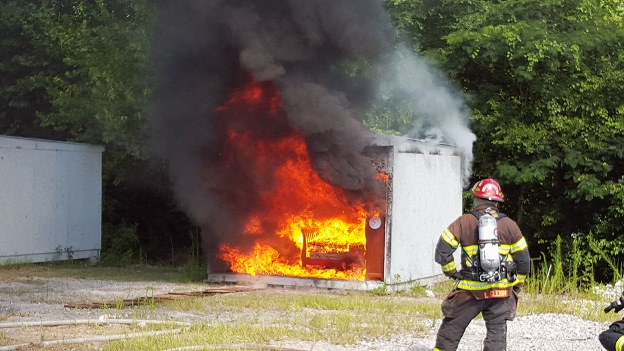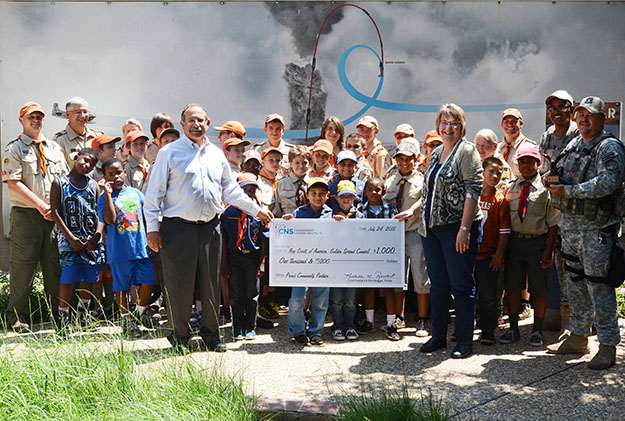Pantex Blog
CNS, University of Tennessee Partner on New Fire Protection Program
Fire is a significant threat to industrial facilities. To enhance our fire protection expertise, CNS has partnered with the University of Tennessee, Knoxville, on a new graduate-level engineering program.

The Graduate Certificate Program in Fire Protection Engineering gives our employees new educational and career opportunities while improving the CNS enterprise’s fire protection capabilities. Twenty five CNS employees from a cross-section of organizations are acquiring critical skills in fire protection engineering while earning graduate-level credit.
Y 12 Fire Protection Engineering Manager David Greer and UT Electrical Engineering and Computer Science professor David Icove got the program rolling. Greer contacted Icove in January 2014 about teaching a course on Fire Dynamics Simulator software to his staff. The two discussed the idea and determined a university program, comprising several core courses open to all engineering students, would better serve CNS and UT.
Fire protection engineering uses the fundamental principles of advanced science and engineering to protect people, property, and the environment from fire. The field is facing a shortage of qualified engineers, so the graduate certificate program makes specialized training available to CNS engineers from different disciplines, as well as UT students studying engineering and related fields.
“As a profession, fire protection engineering is in high demand, and there is a very short supply of qualified engineers. Currently, only two schools in the U.S. offer accredited engineering degrees — Oklahoma State University and the University of Maryland. UT is now the only university in the southeast offering accredited coursework in this field,” Greer said.
The UT Fire Protection Engineering program, which launched in fall 2014, offers four graduate-level courses. The courses combine industry perspective with university expertise, and class assignments are designed around real Pantex and Y 12 problems. Icove, an internationally recognized forensic engineering expert with more than 40 years of experience in the field, teaches the courses.
The initial 16 week program met with success, so this summer UT offered each of the four courses in condensed three week sessions. “This special compressed program is intense,” Greer said. “In a one week period, the students get a semester’s worth of time in class, plus two weeks for homework and a term paper. In three weeks, they’ll complete a graduate-level engineering course but will only be away from the plant for four days. The format is very demanding, but it is the only way many of the participants would ever have time available to take these courses.”
CNS Chief Fire Protection Engineer Randy Lanham said engineers at the Pantex Plant who have taken courses have been impressed. “One engineer said he can use the information in his job right now — which is a big positive. Another said taking the courses has encouraged her to continue with a master’s degree in fire protection engineering,” Lanham said.
Matthew Alt, a UT civil engineering graduate who now supports Uranium Processing Facility Quality Assurance, said the program is a great opportunity to obtain training in a different field.
“We perform a lot of oversight reviews, and these courses provide the tools and training for reviewing process and program documents like the Preliminary Fire Hazards Analysis.”
The curriculum offers CNS the opportunity to provide new educational and career opportunities to employees and to target qualified fire protection engineering candidates likely to establish careers locally. “We hope to see this develop into a full master’s program in the near future,” Greer said.
Greer is appreciative of the commitment and support he has received while working through the details of starting the program. “I had to work through the process, but every person, without exception, has been positive about the program. Not once did anyone say ‘no,’ ‘stop,’ or ‘slow down’ — it was always ‘Great idea! What can we do to help?‘” He credits Linda Bauer, Mike Beck, Tom Christman, and Debbie Reed for helping get the program launched.
CNS President Message to Employees
A message from Jim Haynes, Consolidated Nuclear Security President and CEO, and Morgan Smith, CNS COO to employees.
The Pantex Metal Trades Council (MTC) has notified us that its membership voted last Thursday to not ratify the company’s proposal for a new labor agreement. The current collective bargaining agreement with the MTC expired at midnight Friday, and the MTC has chosen to strike.
We and the rest of the CNS senior management team have great respect for the work performed by the dedicated employees of Pantex and Y-12. Across a broad array of jobs and functions, we all serve critical roles on the front lines of global nuclear security. Our nation depends on us to do our job with excellence every day. The sense of importance and responsibility is very tangible to us, as is the pride that we see in all of you, your families, and the community when it comes to our role protecting and serving this great nation. Our MTC-represented employees equally share in this pride and service to the nation, and we ask that everyone respect them during this difficult time.
Our responsibility to the nation always hinges on a unique balance. We do very special things for the nation, things that no one else does, and we expect to be recognized for this. At the same time, our work is accomplished spending taxpayer dollars and it is incumbent upon each of us to be good stewards of the funds entrusted to us to do our work and to ensure a sustainable future for our sites. Tax dollars are used for all aspects of our work, including funding programs, engineering, research, procurements, maintenance, security, safety, other essential business functions, as well as employees’ salaries and benefits. Therefore, the challenge is to appropriately balance the recognition of the roles of our employees in accomplishing our unique mission while being respectful of taxpayer funds.
Throughout this contract, it has been our sincere desire to maintain wages and benefits that appropriately recognize the important work performed at our sites. However, as has been stated in prior communications, our initial set of changes had greater impact on those involved than was originally anticipated. We are in the process of rolling out an upgraded package for next year in an effort to improve this situation. We worked to reflect this revised approach in the MTC package so that we remain in a very strong position when compared to other industries in the sites’ regions and across the country, including pension programs and other benefits.
We are disappointed that we were not able to achieve an agreement with the MTC. We have acted in good faith with the MTC negotiating team and attempted to find the balance discussed above between rewards and our responsibility to the taxpayers. It is a priority to work together with the MTC to promote the health, safety, and professional growth of its members as well as the long-term viability of Pantex and the local community. After nearly seven months of negotiations, however, our efforts to map out a new contract, resolve identified issues, and stretch our ability to enhance certain areas of the proposal have not resulted in an agreement. We revised our best and final offer last Thursday to what we understood would best achieve the desires and constraints of all parties, and with the strike, we now know that there remains a disconnect between what we are in a position to provide and what MTC members desire.
Pantex will operate in a safe and stable mode this week and throughout the work stoppage. We know this work stoppage will create extra responsibilities requiring additional time for many of you, and we sincerely appreciate your willingness to fill in where needed to keep the plant functioning. We ask that you be mindful of the importance of your role and seek to perform it with the safety, security, quality, and overall excellence that our nation requires. As always, we thank you for your dedication and service to our nation. We will keep you informed as the contract situation with the MTC continues to develop.
Jim Haynes, President and CEO
Morgan Smith, COO
Workforce Message: Respect in the Workplace
Work at Pantex continues after CNS was informed by the MTC that its membership voted not to ratify the company’s proposal for a new labor agreement. Work will be available for all employees, including employees represented by the Metal Trades Council. Each MTC employee is facing difficult personal decisions in exercising their legal right to choose to continue reporting to work, and they deserve everyone’s respect throughout this process. Respect in the workplace is a vital element of the CNS Code of Conduct, which provides for a safe and supportive environment where all employees can work free from unlawful intimidation, discrimination, and harassment of any kind. CNS expects all employees to continue to comply with this Code of Conduct and applicable labor laws.
Boy Scouts tour Pantex
About 40 Cub and Boy Scouts from Amarillo recently had the chance to tour the Pantex visitor’s center and learn more about the history of the plant and its mission.
The scouts, from Troops 86 and 702, are part of the Golden Spread Council, and executive scout assistant Bob Altman said this kind of opportunity will have long reaching effects.
“We’re thrilled to be able to come out here. These young men are excited to be here, and you never know what seed was planted in the minds of these scouts. They may even work out here someday. This is really a great opportunity for them.”
Along with the tour, the Golden Spread council received a check for $1,000 from Consolidated Nuclear Security in support of their organization.

CNS supports Girl Scout Luncheon
Consolidated Nuclear Security, LLC was a proud corporate sponsor of the recent Women of Distinction award luncheon hosted by Girl Scouts of Texas Oklahoma Plains. The event is an annual celebration of influential women in the Texas and Oklahoma Panhandles who support Girl Scout leadership programs.

Pantex Site Manager Michelle Reichert (third from right) was joined at the Girl Scouts Women of Distinction award luncheon by Pantexans Jessie Phifer, Halianne Crawford, Brandy Ramirez, Courtney Waddell, Mig Owens, Rebecca Heinen and Christa Glasgow
Savannah Gates, a former Pantex process engineer, was honored with the Discover Award for her work on a tiny house project. Gates, along with Pantex engineers Rebecca Heinen, Brandy Ramirez and Courtney Waddell, joined forces with Girl Scouts and community volunteers to turn an old camper into a tiny home for a woman in need. Pantexans have also demonstrated their commitment to Girl Scouts through the S’More Engineering and Smart Cookies programs.

Savannah Gates, former Pantex engineer, accepts the Discover Award at the Girl Scouts Women of Distinction Award luncheon.
